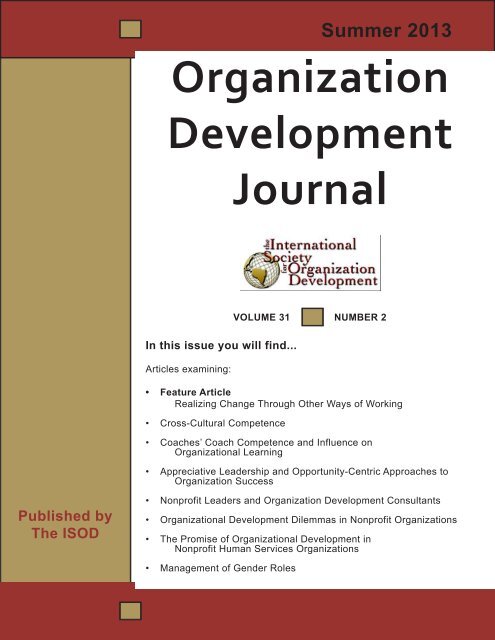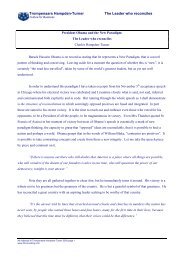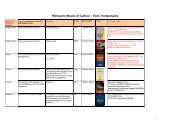Realizing Change Through Other Ways Of Working - Trompenaars ...
Realizing Change Through Other Ways Of Working - Trompenaars ...
Realizing Change Through Other Ways Of Working - Trompenaars ...
- No tags were found...
You also want an ePaper? Increase the reach of your titles
YUMPU automatically turns print PDFs into web optimized ePapers that Google loves.
facing in business. So a person-based culture isoften the result of a leader that strives for a corevalue of entrepreneurship and innovation whilehaving an envisioned future of becoming the mostpathbreaking organization in the field of crossculturalmanagement thinking and consulting. A task/goal driven culture is a much better suited context forleaders that want to help clients gain the highest returnon their investments in the financial service sectorholding a core value of integrity and transparency.But business environments and challengesare changing continuously. Once an organizationalculture has established itself, it creates newdilemmas (or its changing environment will) on ahigher level. For example, a dominant person-basedculture can create a business environment wheremany innovative ideas are born but where themanagement and commercialization of these begson aspects of a more market sensitive task/goaldrivenculture. Conversely, a dominant task/goaldrivenculture can lead to an environment whereemployees are so much guided by their market pricethat it needs a power-based (family) culture to createa necessary longer term vision and commitment.By asking leaders of organizations to phrasethe major tensions they feel as “on the one hand…onthe other” we linguistically program them to see bothsides of the equation (<strong>Trompenaars</strong> & Hampden-Turner, 2002). In order to facilitate this balance inthe approach as well as the link to business, we use anumber of pro-formas to elicit the basic descriptionof their current and ideal organizational cultureprofiles, components they want to retain and discard,as in the following basic framework seen in Figure 3:Figure 3. Sample Pro-forma to Elicit Basic Descriptions ofCurrent and Ideal Organizational Culture Profile.We ensure that the various lists comprisethose that are most crucial to reconcile in viewof the envisioned future. We make sure that theformulation of the horns of the dilemma areboth desirable and are linked to business issues.Examples are: “on the one hand we need to focuson reliable technology (typical for a dominant rolebased culture), whilst on the other we need to beconstantly informed by our main customers (typicalfor dominant task/goal based culture)” or “On theone hand we need to constantly mentor and coachour young graduates for constant learning (person-based culture) whilst on the other hand we need tofocus on the income of this quarter (task/goal- basedculture)”, or “on the one hand we need to developand sustain a loyal workforce and thrive on rapport(power/family-based culture), whilst on the otherhand we need to be able to judge their performancebased on report (task/goal-based culture).”Reconciling the change tensionsSpace limitations will not allow us to go intoall the detailed steps of the reconciliation processbut we show the basic template (see Figure 4) weare using to graphically represent the dilemma:Woolliams and <strong>Trompenaars</strong> 12
Figure 4. Reconciliation Process of Current and Ideal ValueBehaviorsEssentially this template uses a dual axisin order to invite participants to have the currentvalues and behaviors dialogue with the ideal ones.This dialogue is essentially stimulated by asking thequestion: “how can we through the current value orbehavior that one want to keep get more of the idealvalue or behavior we want to strive for.” To stick toour previous examples, the essence of reconciliationis achieved when we answer the question: “How canwe through focusing on our reliable technology getbetter informed by our customers” or “how can wethrough coaching our young graduates increase theincome of this quarter.” Note that we need to changeour “natural” mindset quite fundamentally. Thetraditional change processes often inquire about howwe can change from one (current) value or behaviorto another (desired) set of values or behaviors. Thecreative juices that are flowing from the integrationof seemingly opposing values is astonishing. Butalso from a process standpoint, resistance to changeis often broken (at least conceptually) because weneed to keep and further develop the values thatare positively graded of the existing state of theorganization. It is a process of enriching valuesthrough change rather than replacing one value orbehavior by another. And be aware that the spiralstarts at the side of the current value/behavior axis andgoes through the aspired value to an end somewhereat 10/10 where both values are integrated on ahigher reconciled state. Once this position has beenachieved conceptually it is time for the final stages.Once the leader or groups of relevantleaders are in agreement on the dilemmas that needto reconcile, the action points to be taken evolvenaturally. Very often it is crucial to know the typicallevers that need to be pulled in an organization toincrease the effectiveness of the actions that needto be taken. This very often is very dependenton the type of organizational culture that theorganization currently holds. In family-orientedcultures, the function of human resources oftenplays a crucial role, while marketing and financedominates in the task/goal-based cultures. The bestlevers to be pulled in the person-culture are oftenrelated to learning systems and intrinsic rewardswhile, in the role-based systems, procedures andmanufacturing often play a crucial role. We usethe following template (Table 3) to give someguidance to look at the action points to be taken:13Organization Development Journal • Summer 2013
Table 3. Process Guidance for Action PointsWhilst the leadership will need initiallyto operate at the macro-level, the same thinkingneeds to be cascaded down so that the organizationbecomes a reconciling organization throughout.Whose agenda?There is a potential scenario that this logicalsystematic process can be used to achieve political/personal whims of the leader on the basis that it isobjective and rational. We can overcome this byquantifying the pay-offs of alternative courses ofaction. Thus by assessing the current status of thedilemma against an ideal state that would result whenthe business benefits had been realized so that we arenow in a position to now evaluate the business benefitsagainst the costs, time scales to realize benefits,and the degree to which the dilemma solution islocated in one profit center or involves co-operationacross a number of business units as in Figure 5.Figure 5. Dilemma Portfolio AnalysisThis type of analysis provides an objectiveevaluation of where the highest return on investmentcan be achieved in resolving the dilemma conflictsand thus secures the best benefits to the business.In the particular example shown, themost important cultural dilemma that needed toWoolliams and <strong>Trompenaars</strong> 14
e addressed was the need for facilitating staff towork more remotely using new technology versusmanagement expectation to keep staff under theirobservation in a central office. When faced withmajor decisions like these involving high levelsof funding new technology, training, and humancapital offset by office space savings, such analyticalapproaches help leaders to validate their tacit insightsby making them explicit and open them to debate.Linking culture to business performanceDuring the last twenty years, the fact thatnational and organization culture both need to beconsidered in modern business management has beenincreasingly recognized. And furthermore, a leader,even in a local company, will find they are leadingand managing a workforce that is multi-cultural.Many of the conceptual frameworks for explicatingculture are based around describing how differentcultures give different meanings to relationshipswith other people, the meaning they give to theirinteraction with the environment, and to time andby other similar cultural dimensions. Similarly,much attention has been given to the recognitionand respect for cultural differences. However, if westop at only these first two stages, we run the riskof supporting only stereotypical views on cultures.<strong>Through</strong>out this research we haveadopted a broadly inductive approach—with bothquantitative and qualitative data collection andanalysis. Data has been accumulated over timefrom our consulting as and when it arose basedon client needs, but also we have sought to collectdata pro-actively to fill in the gaps in our inquiry.The extensive data from these multiple sourcesserves to provide triangulation to our evidence.We can claim high reliability from our quantitativequestionnaire-based studies and high validity fromour in-depth interviewing, consulting, and coaching.Conclusions<strong>Through</strong> our methodology, we havehelped many client organizations reconcile suchdilemmas. <strong>Of</strong> course, as soon as you remove one,another pops up. But in today’s rapidly changingever oligopolistic world, it is the very essence oforganizations. Our aim has been to raise the debatefor a new logic for the management of change.So our agenda follows the logic that in orderto secure long-term success as an organization, thecultural dilemmas between the various stakeholdersneed to be reconciled. Since innovation could bedefined as combining values that are not easilyjoined, essentially this process is created by andleads to innovation. It is the innovative capabilityof organizations, from process to product, fromresearch and development to human resources thatwill make an organization sustainable. And it isfar more than just Corporate Social Responsibility!~~~~~~~~~~15Organization Development Journal • Summer 2013




